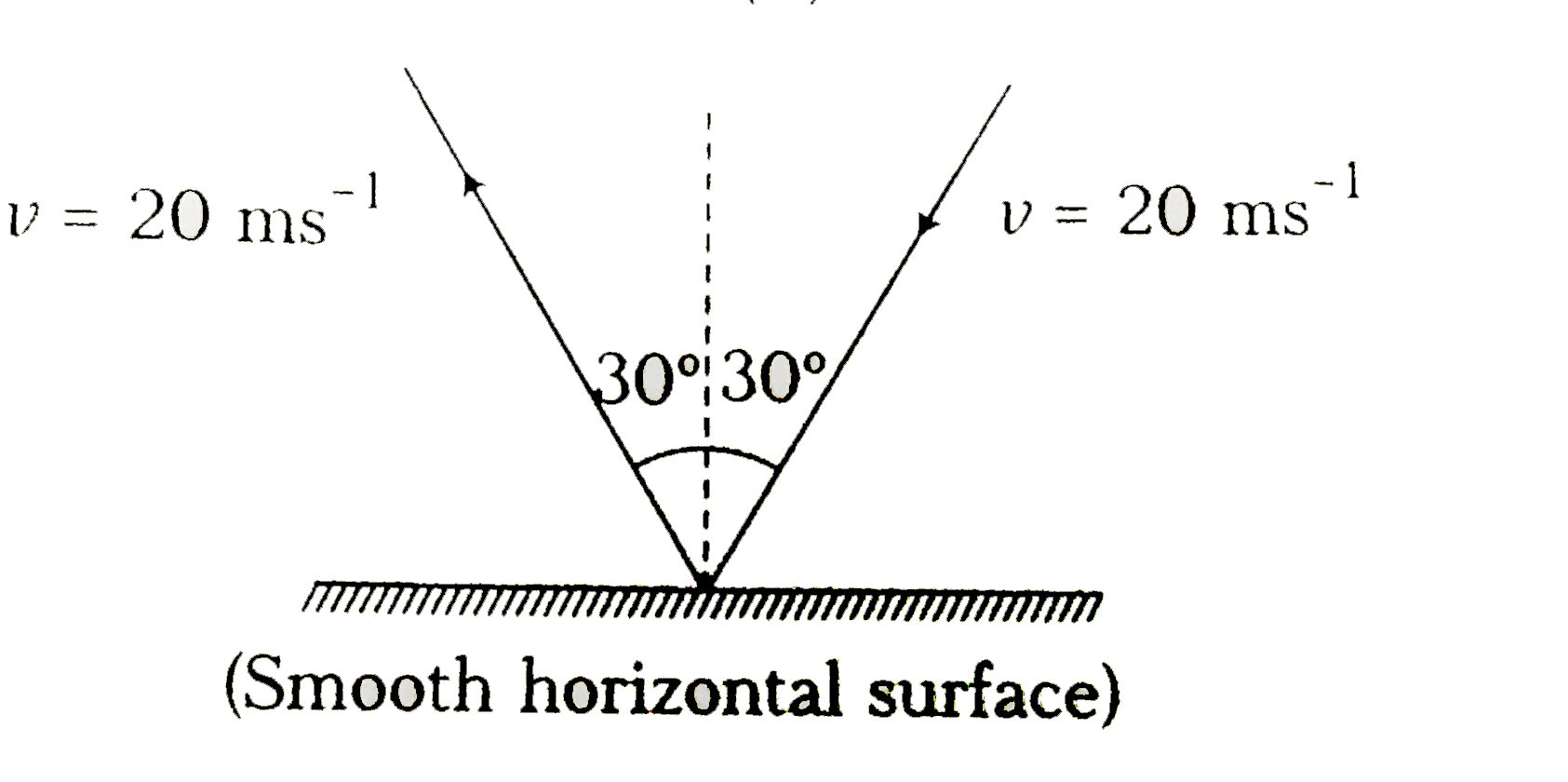A ball with initial speed of10m/s collides elastically with two other identical balls at rest as shown in figure, whose centres are on a line perpendicular to the initial velocity and which are initially in contact with each other.All the three balls are lying on a smooth horizontal table. The first ball is aimed directly at the contact point of the other two balls.All the balls are smooth. Find the velocities of the three balls after the collision.

The correct Answer is:[2m/s,6.93m/s at 30∘with incident direction]
Topper's Solved these Questions
- LINEAR MOMENTUM & ITS CONSERVATIONBook:PHYSICS GALAXY - ASHISH ARORAChapter:LINEAR MOMENTUM & ITS CONSERVATIONExercise:exercise 1.3
Explore 3 Videos
- LINEAR MOMENTUM & ITS CONSERVATIONBook:PHYSICS GALAXY - ASHISH ARORAChapter:LINEAR MOMENTUM & ITS CONSERVATIONExercise:Advance McQ
Explore 20 Videos
- KINEMATICSBook:PHYSICS GALAXY - ASHISH ARORAChapter:KINEMATICSExercise:Unsolved Numerical Pro.
Explore 83 Videos
- NEWTONS LAWS OF MOTIONBook:PHYSICS GALAXY - ASHISH ARORAChapter:NEWTONS LAWS OF MOTIONExercise:Unsolved Numerical Problem
Explore 81 Videos
Similar Questions
Consider 3 identical balls, each having mass of 0.1 kg. The ball A has an initial velocity of 10√3m/s. It then collides simultaneously with balls B and C, whose centres are on a line perpendicular to the initial velocity of the ball A. They are initially in contact with each other and are at rest. The ball A is aimed directly at the contact point of B and C. After the collision, if the ball A comes to rest, then
View SolutionA ball A of mass M collides elastically with a similar ball B at rest as shown in figure. Initially velocity of ball A is u m/s. After collision,

View Solution
Knowledge Check
Consider 3 identical balls, each having mass of 0.1 kg. The ball A has an initial velocity of 10√3m/s. It then collides simultaneously with balls B and C, whose centres are on a line perpendicular to the initial velocity of the ball A. They are initially in contact with each other and are at rest. The ball A is aimed directly at the contact point of B and C. After the collision, if the ball A comes to rest, then
ACollision in elastic.BCollision is inelastic and final kinetic energy of the system-Initial kinetic energy of the system = 5JCCollision is inelastic and final kinetic energy of the system - Initial kinetic energy of the system = - 5JDCollision in elastic, but the final kinetic energy of the system is less than the initial kinetic energy of the system.A ball A of mass M collides elastically with a similar ball B at rest as shown in figure. Initially velocity of ball A is u m/s. After collision,
 ASpeed of ball B is u sinθBVelocity of ball A is usin2θˆi+usinθcosθˆjCSpeed of ball A is ucosθDVelocityofballBisu cos theta sin theta hati + u cos^2 theta hatj
ASpeed of ball B is u sinθBVelocity of ball A is usin2θˆi+usinθcosθˆjCSpeed of ball A is ucosθDVelocityofballBisu cos theta sin theta hati + u cos^2 theta hatjA ball is moving with speed 20ms−2 collides with a smooth surface as shown in figure. The magnitude of change in velocity of the ball will be
 A10√3ms−1B20√3ms−1C40√3ms−1D40ms−1
A10√3ms−1B20√3ms−1C40√3ms−1D40ms−1
A heavy ball of mass 2M moving with a velocity v0 collides elastically head on with a cradle of three identical ball each of mass M as shown in figure. Determine the velocity of each ball after collision.

View SolutionA heavy ball of mass 2M moving with a velocity v0 collides elastically head on with a cradle of three identical ball each of mass M as shown in figure. Determine the velocity of each ball after collision.

View SolutionA ball is moving with speed 20ms−2 collides with a smooth surface as shown in figure. The magnitude of change in velocity of the ball will be

View SolutionA ball is moving with speed 20ms−2 collides with a smooth surface as shown in figure. The magnitude of change in velocity of the ball will be

View SolutionTwo identical balls each of mass m interconnected by a small light inextensible string are kept on a smooth horizontal surface. One of the balls is pushed towards the other with a speed v0 find the loss of K.E. of the ball. What will be the final velocities of the balls ? (e=1).

View Solution
